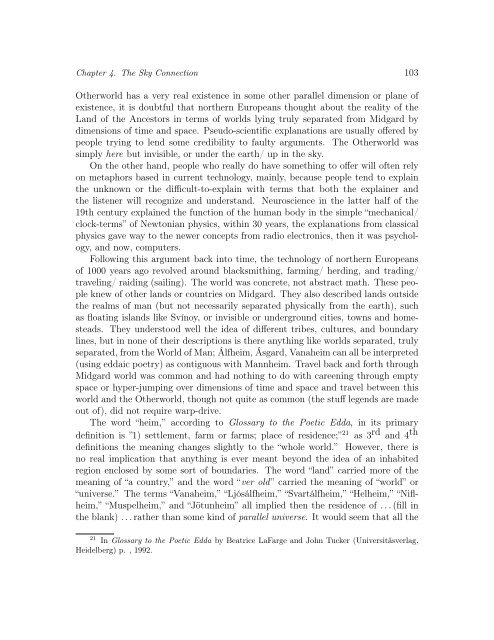Untitled - Awaken Video
Untitled - Awaken Video
Untitled - Awaken Video
You also want an ePaper? Increase the reach of your titles
YUMPU automatically turns print PDFs into web optimized ePapers that Google loves.
Chapter 4. The Sky Connection 103<br />
Otherworld has a very real existence in some other parallel dimension or plane of<br />
existence, it is doubtful that northern Europeans thought about the reality of the<br />
Land of the Ancestors in terms of worlds lying truly separated from Midgard by<br />
dimensions of time and space. Pseudo-scientific explanations are usually offered by<br />
people trying to lend some credibility to faulty arguments. The Otherworld was<br />
simply here but invisible, or under the earth/ up in the sky.<br />
On the other hand, people who really do have something to offer will often rely<br />
on metaphors based in current technology, mainly, because people tend to explain<br />
the unknown or the difficult-to-explain with terms that both the explainer and<br />
the listener will recognize and understand. Neuroscience in the latter half of the<br />
19th century explained the function of the human body in the simple “mechanical/<br />
clock-terms” of Newtonian physics, within 30 years, the explanations from classical<br />
physics gave way to the newer concepts from radio electronics, then it was psychology,<br />
and now, computers.<br />
Following this argument back into time, the technology of northern Europeans<br />
of 1000 years ago revolved around blacksmithing, farming/ herding, and trading/<br />
traveling/ raiding (sailing). The world was concrete, not abstract math. These people<br />
knew of other lands or countries on Midgard. They also described lands outside<br />
the realms of man (but not necessarily separated physically from the earth), such<br />
as floating islands like Svínoy, or invisible or underground cities, towns and homesteads.<br />
They understood well the idea of different tribes, cultures, and boundary<br />
lines, but in none of their descriptions is there anything like worlds separated, truly<br />
separated, from the World of Man; Álfheim, Ásgard, Vanaheim can all be interpreted<br />
(using eddaic poetry) as contiguous with Mannheim. Travel back and forth through<br />
Midgard world was common and had nothing to do with careening through empty<br />
space or hyper-jumping over dimensions of time and space and travel between this<br />
world and the Otherworld, though not quite as common (the stuff legends are made<br />
out of), did not require warp-drive.<br />
The word “heim,” according to Glossary to the Poetic Edda, in its primary<br />
definition is ”1) settlement, farm or farms; place of residence;” 21 as 3 rd and 4 th<br />
definitions the meaning changes slightly to the “whole world.” However, there is<br />
no real implication that anything is ever meant beyond the idea of an inhabited<br />
region enclosed by some sort of boundaries. The word “land” carried more of the<br />
meaning of “a country,” and the word “ver old” carried the meaning of “world” or<br />
“universe.” The terms “Vanaheim,” “Ljósálfheim,” “Svartálfheim,” “Helheim,” “Niflheim,”<br />
“Muspelheim,” and “Jötunheim” all implied then the residence of . . . (fill in<br />
the blank) . . . rather than some kind of parallel universe. It would seem that all the<br />
21 In Glossary to the Poetic Edda by Beatrice LaFarge and John Tucker (Universitäsverlag,<br />
Heidelberg) p. , 1992.
















